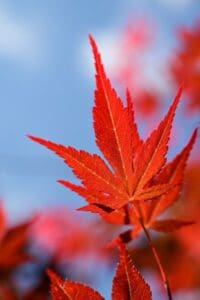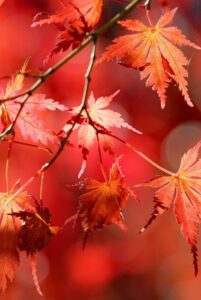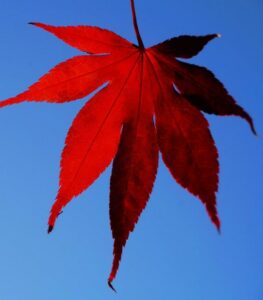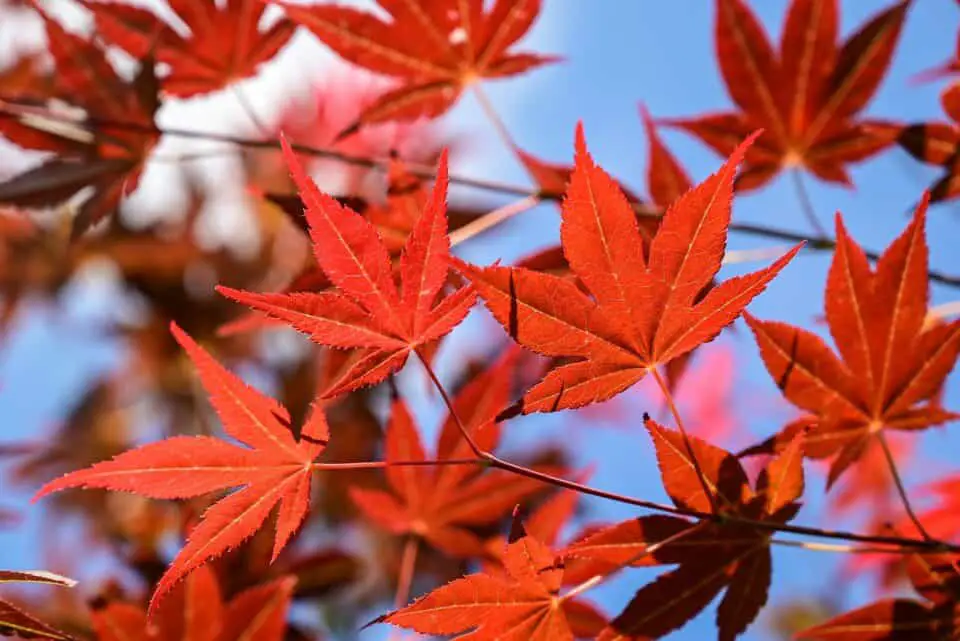Some links in the post are affiliate links and I get a commission from purchases made through some links found in the post.
Japanese maple trees are known for their colorful foliage. The striking color becomes even more beautiful during the fall.
However, it becomes alarming when the gorgeous leaves turn brown because their color is the most prominent feature. If your maple tree is facing the same issue and you need help, we are on it!
Your Japanese maple tree may be turning brown because of lack of water (dryness or drought), excessive fertilizer, or physical damage to the tree’s roots.
It can also be due to excess watering, space restriction, or exposure to strong winds, all of which damage the plant, making it more prone to injury.
But don’t worry because we have listed all the problems and their solutions in detail to benefit you. So keep on reading if you want your Japanese Maple to stay healthy and colorfully delightful.
Why is my Japanese Maple Turning Brown?
 The delicate and colorful foliage of Japanese maple trees (Acer palmatum) is treasured throughout the growing period and autumn.
The delicate and colorful foliage of Japanese maple trees (Acer palmatum) is treasured throughout the growing period and autumn.
Based on the variety, this fairly small, slow-growing plant can reach fully grown heights of 4–30 feet.
Although the tree blooms in the early summer, it’s the palmate leaves with five, seven, or nine toothed cusps that stand out.
Most Japanese maples are hardy in USDA zones 5–8, with a few surviving in zone 4 if grown in nature reserves.
Japanese maples thrive in full to the limited sun and well-drained soil. In zones 7–8, plant them in a location with part shade or speckled sunlight to protect the greenery from the summer heat.
Many popular varieties have red vegetation, but some have vivid green or gold hues. While there are many contexts for choosing a Japanese maple, most people plant this plant because of its leaves.
Following are some of the reasons why your maple tree might be losing its beautiful foliage:
1) Leaf scorch
In their natural habitats, Japanese maple trees grow under tall trees.
Overexposure to sunlight can cause the Japanese maple leaves to start turning brown. This condition is known as leaf scorch
Even trees that are overly placed under the sun can suffer from browning during a hot summer, particularly if other disabling elements are present.
In terms of symptoms, it is a matter of degree. Only a few leaves will brown, and only at the margins, the mildest cases.
The uppermost leaves are involved chiefly. Too much sunlight can also cause stress-induced color change leading to wilting.
How to fix it:
Panic leads to nothing, so first, calm down. There may be no doubt that your precious Japanese maple is shedding its leaves and turning brown, but it is only the aftereffect of the dry, hot summer.
Summer drains out the juices of every plant if placed in direct sunlight, so don’t be alarmed. The plant may be standing naked but don’t consider it dead just now.
The plant will bloom its second set of buds, and new leaves will appear. Don’t spray it with fertilizer; rather, the cure lies in repositioning the plant to an area where it can get some shade.
Place the plant near a window getting in direct sunlight, or if it is placed outside, place it near a taller tree so that it gets covered by shade.
The more towering tree will protect the plant against scorching sunlight. In addition, the shade provided by the taller tree can mimic the plant’s natural habitat that it gets in the forest or natural breeding area.
2) Less water
If your Japanese maple is in a shady location or you have now repositioned your tree to a new spot, the plant is still becoming dull, and the leaves are turning brown; the heat and the lack of water are likely causing it the scorch.
Japanese maples are small, but they might quickly dry without hydration. So remember to water your beloved tree frequently.
How to fix it:
During dry spells, make sure to hydrate your maple tree thoroughly. A deeper watering completed less commonly is preferable to a shallower watering accomplished more regularly.
The goal is to keep the soil moist but not mushy. Rather than attempting to devise a full-proof irrigation schedule, check your soil in between waterings to make sure it isn’t completely drying out.
You may also like: Japanese maple vs red maple
3) Excess Fertilizer
Fertilizer and mulch lock in moisture. This makes your tree hydrated enough. However, don’t over-fertilize the trees. You should fertilize the soil as needed.
Provide adequate micro-nutrients (iron or manganese) to the tree if it lacks a specific nutrient. Think and care about your plant and get to know your plant more by researching.
How to fix it:
When using chemical fertilizers, cautiously follow the directions. In general, the best time to fertilize Japanese maple trees is in early autumn or early spring.
Just use compost if you don’t want to worry about being exact with your fertilizing regimen. Compost doesn’t harm the plant and can be used whenever desired.
4) Exposed root system:
If the roots are exposed and become dried out in shallow soil, the plant becomes prone to dehydration and can thus turn brown.
How to fix it:
Use mulch and spread it around the plant. This will protect the root system. However, if exposed to the air, the plant can quickly dry up and face browning and ultimately death.
5) Root rot:
 Root rot is also known as Verticillium Wilt. Japanese maples are relatively susceptible to fungal pathogens. Verticillium pathogens that affect Japanese Maple grow in damp soils.
Root rot is also known as Verticillium Wilt. Japanese maples are relatively susceptible to fungal pathogens. Verticillium pathogens that affect Japanese Maple grow in damp soils.
The symptoms of Verticillium are browning, greying, yellowing, and curling inwards or certain branches dropping their leaves.
This is a disease that affects the root due to the dampness of the soil. Japanese maple trees are acclimatized to growing soils with a rich organic composition.
The compost should have nutrient-absorbing properties but allow excess water to drain away readily.
If the soil drains too slowly, or the plant is in a mushy region of the garden, or you’re overwatering the plant, all these factors lead the soil to become saturated.
A well-draining soil helps the plant to bloom and grow properly. Thus, both overwatering leading to root rot and underwatering are harmful to the plant’s growth.
How to fix it:
Place the plant in well-draining moist, not soggy soil. Don’t overwater the plant and use fungicides if wanted.
6) High wind exposure:
Brisk winds dry out the plant, which can also lead to browning and drying of the plant.
How to fix it:
Select a sheltered spot when planting a Japanese maple tree so that it will not be exposed to high winds.
To help with this, check out our article on where should you plant a Japanese maple tree.
7) Bugs and Pests:
Japanese maples are pretty resistant to pests, but they still are not immune to pest problems. Aphids and scales are the most common to affect the plant.
On the bright side, these aphids and scales cannot kill the plant but can turn the plant brown and cause the leaves to fall early.
Leaves turning brown at the edges, curling, withering, and death are common problems when infected with bugs and pests.
How to fix it:
Keep the maple tree free from bugs with a swift water blow and use occasional insecticide if the problem is not diminished.
8) Chemical applications
Japanese Maples are sensitive to chemical insecticides and fungicides. Therefore, don’t unnecessarily infect your plant with them.
How to fix it:
If you need to control the insects, a mild solution of seven sprays or neem oil at a diluted strength can be used to keep away the pests. To reduce the leaf scorch, you should spray in the early morning.
9) Excess water:
Excess water added to the soil can cause the soil to puddle, and the roots will die in the waterlogged soil.
How to fix it:
You should add claystone to absorb the water and restore the water balance.
Inkberry, summersweet, black chokeberry, and American cranberry bush are some shrubs that can absorb the excess water when added to the soil.
10) Unsuitable soil:
The land should be suitable if you want the plant to strive and not to end up brown. Always test the soil to make it ideal for your precious maple tree.
11) Iron deficiency
Iron chlorosis is the lack of iron, and it causes a problem for the plant. Iron is essential and is necessary for the plant to photosynthesize normally.
If the leaves are looking yellow to brown and the nerves are green. Later, the leaves dry up and fall off.
How to fix it:
Several steps must be taken to resolve the issue. The most important thing is to provide iron to the plant, so water it with iron chelators.
However, you must also test the pH of both soil and water sources. This number has to be somewhere around 4 and 6. If both seem alkaline (pH greater than 7), you must change it.
In the first case, plant it in pots with acidified plant substrate or coconut fiber and acidify the irrigation with lemon water or citric acid. When using synthetic fertilizers, carefully follow the instructions.
12) Insufficient space.
Growing the Maple in a pot may also damage the plant. The leaves turn brown prematurely, and the shrub or tree will not last long.
The space restriction also makes the care of the plant difficult.
How to fix it:
When you assume that the plant requires a larger pot, transplant it in early fall before it begins to lose leaves.
Choose a container with holes in the base that is 5-10 centimeters larger in diameter and depth.
You may also like: 6 benefits of a owning a Japanese maple
Final Thoughts
 Japanese maple trees have striking and colorful red golden leaves that are the most esteemed features of this plant. The plant is relatively small and grows slowly.
Japanese maple trees have striking and colorful red golden leaves that are the most esteemed features of this plant. The plant is relatively small and grows slowly.
The leaves can turn brown due to many reasons, including overexposure to sunlight. This is called leaf scorch. The leaves may also brown because of dehydration so remember to water the plant as needed.
Fertilizing the soil is also important. When using chemical fertilizers, cautiously follow the directions.
The trees are susceptible to fungal pathogens, therefore should also not be placed in soggy soil. Japanese maple trees are hardy, but aphids and scales are still the most common to affect the plant.
Choosing suitable land is also vital for the plant’s proper growth, e.g., land deficient in iron also causes browning. The last reason for browning but not the least is space restriction.
Transfer the tree to a bigger pot if the browning doesn’t subside. You can ensure that your maple tree does not go brown following these general care measures.
About the Author:
Saad Ansar
Saad is an avid gardener himself and is a great lover of plants, animals, photography, & people. Currently, he is focused on photographing indoor plants & captioning beautiful outdoor sceneries. He writes and rewrites in-depth articles on nature and science.


